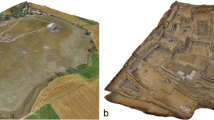Abstract
The appearance of computers as super-brain inspires the hope that archaeology will solve the problem of the multidimensional data presentation. Since 1970s, the international conferences on the computer application in archaeology have discussed the advantages of new technologies. During one of them in 1990, the term virtual archaeology was introduced for the first time by Paul Reilly. He discussed both possibilities: visualizing in the computer screen the total amount of data obtained from the fieldwork and using the technologies applied in the computer games production for scientific aims. The word visualization also became the keyword of the definition given 20 years later in the International Charter on Virtual Аrchaeology. However, in 2007, this interpretation was exposed to critic. Virtual archaeology aims at the application of computer technologies for the creation of high-quality images of archaeological objects as well as in assistance to the archaeological studies. Time has gone; many applied sciences introduced computer technologies, and the possibility to unify and accumulate, to analyse and to demonstrate data appeared. Today, any big scientific research of the archaeological monument supposes the application of natural sciences and computer technologies. The archaeological excavations and virtual archaeology are parts of one infinite process, and the virtual archaeology means all the newest kinds of computer technologies used for archaeological investigations, data processing, modeling, archaeological and historical reconstruction and evident representation of their results. Since the time of Paul Reilly’s definition, the meaning of the term virtual transformed from imaginary to existing in our understanding. It looks curious, but maybe very soon, instead of virtual archaeology, it will be possible to say up-today archaeology.
Similar content being viewed by others
References
ABBYY Lingvo.Pro (2011) http://lingvopro.abbyyonline.com/ru/Search/en-ru/virtual. Accessed 15 Jan 2014
CAA (2011) Computer applications and quantitative methods in archaeology. http://caa.leidenuniv.nl. Accessed 15 Jan 2014
Evans TL, Daly P (2006) Digital archaeology: Bridging method and theory. Routledge, USA
Forte M (2000) About virtual archaeology: disorders, cognitive interactions and virtuality. CAA’26. BAR Intern.s. Vol. 84:247–259
Forte M, Guidazzoli F (1997) About virtual archaeology. Musées et hypermedia ICHIM 97, Paris. http://mosaic.infobyte.it/project/towardsa.html. Accessed 15 Jan 2014
Frishcer B, Dakouri-Hild A (2008) Beyond illustration: 2d and 3d digital technologies as tools for discovery in archaeology. In: Frischer B, Dakouri-Hild A (eds) BAR Intern.s. Vol.1805. Archaeopress, Oxford
Frischer B, Niccolucci F, Ryan N, Barceló J (2002) From CVR to CVRO. The past, present, and future of cultural virtual reality. In: Niccolucci F (ed) BAR Intern.s. Vol. 834. Archaeopress, Oxford, pp 7–18
Hermon S, Sugimoto S, Mara H (2007) The London Charter and its applicability. VAST: International Symposium on Virtual Reality, Archaeology and Intelligent Cultural Heritage, Nov 2007
International Charter of Virtual Archaeology (2010) International Forum of Virtual Archaeology http://www.arqueologiavirtual.com/carta/wp-content/uploads/2011/03/Sevilla-Charter.pdf. Accessed 15 Jan 2014
Lévy P (1995) Qu’est-ce que le virtuel? La Découverte, Paris
Lock G (2003) Using computers in archaeology: Towards virtual past. Routledge, London
London Charter Initiative (2009) London Charter for the computer-based visualisation of cultural heritage. Draft 2.1. http://www.londoncharter.org/fileadmin/templates/main/docs/london_charter_2_1_en.pdf. Accessed 15 Jan 2014
Pujol-Tost L (2004) Archaeology, museums and virtual reality. Digithum. UOC. No. 6. http://www.uoc.edu/humfil/articles/eng/pujol0304/pujol0304.pdf. Accessed 15 Jan 2014
Pujol-Tost L (2007) Does virtual archaeology exist? Layers of perception. CAA’2007: 101-107
Reilly P (1991) Towards a virtual archaeology. CAA’90. BAR Intern.s. Vol.565:133–139
Reilly P, Rahtz S (2008) Archaeology and the information age: A global perspective. Archaeopress, Oxford
Slator BM, Clark JT, Landrum III J, Bergstrom A, Hawley J, Johnston E, Fisher S (2001) Teaching with immersive virtual archaeology. Proceedings of the 7th international conference on virtual systems and multimedia (VSMM’01) http://www.stanford.edu/dept/SUSE/projects/ireport/articles/3D/00969679.pdf. Accessed 15 Jan 2014
VAMCT (2013) Virtual archaeology, museums and cultural tourism. International Workshop. Delphi. http://vamct13.syros.aegean.gr/aims-scope.shtml. Accessed 15 Jan 2014
VAST (2011) International symposium on virtual reality, archaeology and cultural heritage. http://www.vast-conference.eu/. Accessed 15 Jan 2014
Virtual archaeology (2013) In: Hookk D (ed) St. Petersburg, The State Hermitage Publishers
Virtual reality in archaeology (2000) In: Barceló JA, Forte M, Sanders DH (eds) BAR International Series Vol. 843. ArcheoPress, Oxford
Ware C (2004) Information visualization: Perception for design. Elsevier Science & Technology Books, San Francisco
Zhai P (1998) Get real: A philosophical adventure in virtual reality. Rowman & Littlefield, Maryland
Acknowledgments
I would like to express my sincere gratitude to my colleagues who kindly discussed details of the article. The fruitful discussion on the topic was also provided by the grant support of the Russian Foundation for Humanities (project nos. 12-03-14006 and 13-21-01003).
Author information
Authors and Affiliations
Corresponding author
Rights and permissions
About this article
Cite this article
Hookk, D.Y. From illusions to reality: transformation of the term ‛virtual archaeology’. Archaeol Anthropol Sci 8, 647–650 (2016). https://doi.org/10.1007/s12520-014-0201-8
Received:
Accepted:
Published:
Issue Date:
DOI: https://doi.org/10.1007/s12520-014-0201-8




